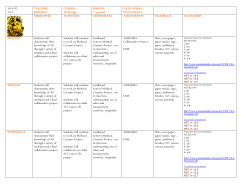
Optical Illusions/Op Art Pattern MANCHESTER TOWNSHIP SCHOOL DISTRICT CURRICULUM
MANCHESTER TOWNSHIP SCHOOL DISTRICT CURRICULUM Content Area: VISUAL ARTS Course Title: Visual Art I Grade Level:9‐12 Optical Illusions/Op Art Pattern Unit Plan 11 Date Created: 4/19/12 Board Approved on: September 19, 2012 7/2012 2 Weeks MANCHESTER TOWNSHIP SCHOOL DISTRICT Unit Overview Content Area: Visual Arts Unit Title: Optical Illusions/ Op Art Pattern Unit Target Course/Grade Level: 9-12 Unit Summary –SWBAT- Understand the theories of human vision, and the use of optical illusions and Op Art in Art and Technology. Students will discover the techniques of creating optical illusions, and study the history of optical illusions in art through the work of artists such as M.C. Escher, Victor Vasarelli, Bridget Riley and others. Students will learn the vocabulary of optical illusions, and the meaning of those terms. Students will learn the science and mathematics of optical illusions and Op Art by creating their own optical illusions and Op Art pieces. They will use measurement and geometry to fabricate their Op Art artworks and original optical illusions. Students will gain an understanding of visual perception, and how we perceive our visual world. By studying optical illusions, students will also learn how to fool the eye, and learn the applications of this in art, business, and the media. Primary interdisciplinary connections: The Science of human vision and perception; the practical application of visual illusions in the Visual Arts, Computer Graphics (CG), and in Business/advertising. 21st century themes: Optical Illusions and Op Art Patterns in the classroom, the workplace, and the science of vision. Learning Targets Standards Content Statements CPI # 12 7/2012 Cumulative Progress Indicator (CPI) NOTE: By the end of grade 12, those students choosing VISUAL ART as their required area of specialization demonstrate PROFICIENCY in the following content knowledge and skills. Common themes exist in 1.1.12.D.1 Distinguish innovative artwork from a variety of applications of the elements of cultures across time and are art and principles of design in communicated through visual artworks from diverse metaphor, symbolism, and cultural perspectives and identify allegory. specific cross-cultural themes. Stimuli for the creation of 1.1.12.D.2 Translate literary, musical, artworks can come from theatrical, and dance many places, including compositions by using them as other arts disciplines. stimulus/inspiration for corresponding visual artworks. 12 7/2012 NOTE: By the end of grade 12, those students choosing VISUAL ART as their required area of specialization demonstrate PROFICIENCY in the following content knowledge and skills. How individuals manipulate 1.3.12.D.1 Synthesize the elements of art the elements of art and and principles of design in an principles of design results original portfolio of two- and in original portfolios that three-dimensional artworks that reflect choice and personal reflects personal style and a high stylistic nuance. degree of technical proficiency and expressivity. Culturally and historically 1.3.12.D.2 Produce an original body of diverse art media, art artwork in one or more art mediums, techniques, and mediums that demonstrates styles impact originality and mastery of visual literacy, interpretation of the artistic methods, techniques, and statement. cultural understanding. The artist’s understanding of the relationships among art media, methodology, and visual statement allows 1.3.12.D.3 Organize an exhibit of personal works of visual art that convey a the artist to use high level of understanding of expressionism, abstractionism how the expression of ideas (nonobjective art), relates to the art media, art realism/naturalism, mediums, and techniques used. impressionism, and other genre styles to convey ideas to an audience. Artists interpret/render 1.3.12.D.4 Analyze the syntax and themes using traditional art compositional and stylistic media and methodologies as principles of two- and threewell as new art media and dimensional artworks in multiple methodologies. art media (including computerassisted artwork), and interpret themes and symbols suggested by the artworks. Two- and three-dimensional 1.3.12.D.5 Identify the styles and artistic artworks can be rendered processes used in the creation of culturally specific by using culturally and historically diverse the tools, techniques, styles, two- and three-dimensional materials, and artworks, and emulate those methodologies that are styles by creating an original germane to a particular body of work. cultural style. 12 NOTE: By the end of grade 12, all students demonstrate PROFICIENCY in the following content knowledge and skills for their required area of specialization in DANCE, MUSIC, THEATRE, or VISUAL ART. Recognition of fundamental elements within various arts 1.4.12.A.1 Use contextual clues to differentiate between unique and disciplines (dance, music, common properties and to theatre, and visual art) is dependent on the ability to discern the cultural implications decipher cultural of works of dance, music, implications embedded in theatre, and visual art. artworks. Contextual clues within 1.4.12.A.2 Speculate on the artist’s intent, artworks often reveal using discipline-specific arts artistic intent, enabling the terminology and citing viewer to hypothesize the embedded clues to substantiate artist’s concept. the hypothesis. Artistic styles, trends, 1.4.12.A.3 Develop informed personal movements, and historical responses to an assortment of responses to various genres artworks across the four arts of art evolve over time. disciplines (dance, music, theatre, and visual art), using historical significance, craftsmanship, cultural context, and originality as criteria for assigning value to the works. Criteria for assessing the 1.4.12.A.4 Evaluate how exposure to historical significance, various cultures influences craftsmanship, cultural context, and originality of individual, emotional, art are often expressed in intellectual, and kinesthetic qualitative, disciplineresponses to artwork. specific arts terminology. Unit Essential Questions What is are optical illusions and Op Art, and how are they created? How do you use line and geometry to create your optical illusions and Op Art pattern? How do optical illusions work with human vision, and how do we perceive our visual world? 7/2012 Unit Enduring Understandings Understanding of optical illusions and Op Art Patterns. Understanding of the theory and mathematics of how human vision is affected, and how to fool the eye. Understanding how to create original optical illusions, and the practical applications of optical illusions and Op Art in art and design. Understanding how optical illusions and Op Art work in Digital Media, film, and other electronic media works. Unit Learning Targets (Objectives) Students will ...be able to understand optical illusions and Op Art Patterns Be able to know and understand the vocabulary of optical illusions and Op Art patterns. Be able to use this basic knowledge to create an original optical illusion and Op Art artwork through guided activities and projects. Students will develop a basic knowledge of the mathematics and science used in the creation of optical illusions and Op Art, and how human vision works in viewing patterns, lines and repeated patterns. Evidence of Learning Formative Assessments Students will be able to explain the Tessellation/Repeated Pattern vocabulary. Students will show an understanding of the creation of an original tessellation, and how they are used in Art. Students will create tessellation artworks through guided activities and projects. Students will understand the parts of the tessellation, and how those elements apply to their artworks. Summative Assessments - Unit Tests Modifications (ELLs, Special Education, Gifted and Talented) -Review and make necessary IEP modifications/504 plan -Differentiated instructional strategies that allow students of different intelligence and ability to achieve success. -Collaborate with ESL department to make necessary modifications for ELL students. Curriculum development Resources/Instructional Materials/Equipment Needed /Teacher Resources: Posters, films/DVD’s, television, slide projectors, computer, paints, brushes, vellum drawing paper, poster board, construction paper, scissors, glue. Teacher Notes: 7/2012
© Copyright 2025




















